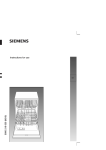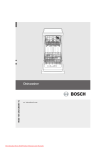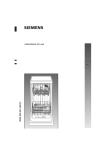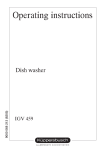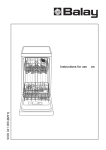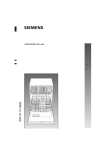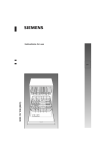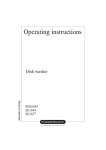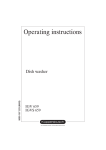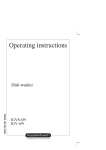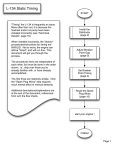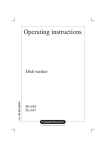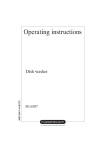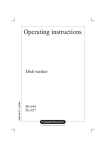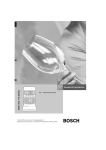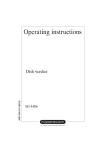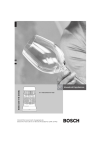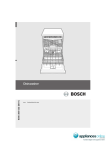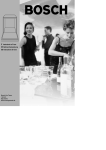Download Bosch SGV 53E33 Dishwasher User Guide Manual Operating
Transcript
Downloaded from DishWasher-Manual.com Manuals
Downloaded from DishWasher-Manual.com Manuals
en
Index
Safety instructions . . . . . . . . . . . . .
Getting to know your appliance . .
Water softener . . . . . . . . . . . . . . . .
Filling the salt dispenser . . . . . . . .
Adding rinse aid . . . . . . . . . . . . . . .
Utensils . . . . . . . . . . . . . . . . . . . . . .
Detergent . . . . . . . . . . . . . . . . . . . .
Programme overview . . . . . . . . . .
4
6
7
8
9
10
13
15
Washing dishes . . . . . . . . . . . . . . .
Additional functions * . . . . . . . . . . .
Maintenance and care . . . . . . . . . .
Fault finding . . . . . . . . . . . . . . . . . .
Customer Service . . . . . . . . . . . . .
Information . . . . . . . . . . . . . . . . . . .
Installation . . . . . . . . . . . . . . . . . . . .
Waste disposal . . . . . . . . . . . . . . . .
Downloaded from DishWasher-Manual.com Manuals
16
17
18
20
23
23
24
25
en
Safety instructions
Delivery
Immediately check the packaging and
dishwasher for any damage which may
have been caused in transit. Do not use
a damaged appliance, but consult your
supplier.
Please dispose of packaging material
properly.
Installation
Install and connect the appliance
according to the installation and
assembly instructions.
The dishwasher must NOT be
connected to the power supply during
installation.
Ensure that the protective conductor
system of the domestic electricity
supply has been installed correctly.
Electrical connection conditions must
correspond with the specifications on
the rating plate of the dishwasher.
If the dishwasher is to be installed
in a high-sided unit, ensure that the unit
is attached properly and also at the
rear.
Built-under and built-in appliances
should always be installed under a
continuous work surface which is
attached to the adjacent cupboards, in
order to ensure that the appliance is
entirely stable.
After the appliance has been installed,
the mains plug should still be easily
accessible.
Not on all models:
The plastic housing on the water input
contains an electrically operated valve.
The connecting wires are inside the
inlet hose. Do not cut through this hose
and do not immerse the plastic housing
in water.
Warning
For safety reasons, if the appliance is not
fitted in a recess, thereby making a side
wall accessible, the door hinge area
should be covered at the side.
(Risk of injury)
Covers are available as optional
accessories from customer services or
specialist stores.
In daily use
Warning
Knives and other sharp-pointed utensils
must be placed with the points down
in the cutlery basket or horizontally in
the utensils basket.
Use the dishwasher only in the
household and only for its designed
purpose, i.e. for washing domestic
dishes.
Do not lean or sit on the open door.
The appliance could tip.
Please note that free-standing
appliances may tip over if the baskets
are overloaded.
The water in the appliance is not
drinking water.
Do not add any solvents to the washing
chamber. Danger of explosion!
Open the door carefully when
the programme is still running. There
is a risk of hot water spraying out of
the appliance.
To prevent injuries, e.g. caused
by stumbling, open the dishwasher
only briefly in order to load and unload
the dishwasher.
Read and observe the safety
nformation and instructions for use on
the packaging for cleaning and rinsing
agents.
4
Downloaded
from DishWasher-Manual.com Manuals
en
Children in the household
If fitted, use the childproof lock. An
exact description can be found in the
back of the envelope.
Do not allow children to play with
or operate the appliance.
Keep children away from detergents
and rinse aid. These may cause
chemical burns in the mouth, throat and
eyes or asphyxiation.
Keep children away from an open
dishwasher. There could still be
detergent residue inside.
If the appliance is installed at eye-level,
ensure when opening and closing the
door that children are not caught
or crushed between the appliance door
and the cupboard door situated below.
Damage
The appliance may be repaired and
opened up by a technician only. First
disconnect the appliance from the
power supply. Pull out the mains plug
(do not tug the power cord!) or switch
off the fuse. Turn off the tap.
Disposal
Make redundant appliances unusable
to prevent subsequent accidents.
Dispose of the appliance in an
environmentally friendly manner.
Warning
Children could get locked in the appliance
(risk of suffocation) or get stuck in other
positions.
Therefore: Remove the mains plug, cut the
mains wire and set aside. Damage the
door lock so that the door can no longer
be closed.
Before using for the first time
The appliance was checked before it left
the works. In order to remove possible
water test remains, use the appliance for
the first time without any dishes, using
the highest temperature. Also fill salt, rinse
aid and detergent in the filling
compartments.
Downloaded from DishWasher-Manual.com Manuals
5
en
Getting to know your
appliance
Diagrams of the control panel and the
interior of the appliance can be found
in the envelope at the front.
Individual positions are referred to in
the text.
Control panel
1
2
3
4
5
6
7
8
Main switch
Door handle
Additional options*
PROGRAMME END indicator
LOW SALT indicator
LOW RINSE-AID indicator
“Check water supply” indicator
Programme buttons
You will need to purchase the
following before using the
dishwasher for the first time:
– special salt for use in dishwashers
– detergent
– rinse-aid
Only use products, which are suitable for
dishwashers.
* on applicable models
Appliance interior
20
21
22
23
24
25
26
27
28
29
30
31
32
33
Top basket
Additional cutlery basket for the top
basket *
Top spray arm
Additional cup rack *
Bottom spray arm
Float **
Bottom basket
Salt dispenser
Filters
Cutlery basket
Dispenser for rinse aid
Detergent dispenser
Catch
Rating plate
* some models
** The float ensures that the appliance
interior is not overfilled. Only customer
service may maintain, remove and install
the float.
6
Downloaded
from DishWasher-Manual.com Manuals
en
Water softener
In order to rinse dishes and glasses
satisfactorily, the dishwasher requires soft
water, i.e. containing little or no lime,
otherwise water stains will be left behind
on crockery and glasses, etc.
If the tap water exceeds a certain level of
hardness, it must be softened, i.e.
decalcified, so that it can be used in the
dishwasher.
This is achieved by adding a special salt
to the water softener inside the
dishwasher.
The water softener, that is the required
amount of salt, is set up according to how
hard the tap water is.
Setting up the water softener
Determine the level of hardness of your
tap water. Your local water company or
service agent can help you with this.
Identify setting from the following water
hardness table.
Hold down the programme button B
and switch on the main switch 1 ,
then release the buttons.
The display 5 flashes and buttons
A and B illuminate.
(Hardness value 2 was set at the
factory).
To change the setting: Press
programme button B .
Each depression of the button
increases the set value by one (0–3).
If buttons A , B and C illuminate,
the maximum hardness value has been
reached.
If the hardness value is now increased
again, the illuminated buttons go out
and the hardness value is set to 0 (no
buttons illuminated).
Switch off the mains switch 1 .
The set value is stored in the appliance.
Approx. 4 litres of water are required for
regenerating the water softening system.
The overall water consumption per load
can therefore be increased by between 0
and a maximum of 4 litres according to the
water hardness setting.
Water hardness table
_dh
A
_fH _Clarke mmol/
l
0–1,1
B
C
Reset
0
0–6
0–11
0–8
7–16
12–29
9–20 1,2–2,9
1
17–21 30–37 21–26 3,0–3,7
2
22–35 38–60 27–44 3,8–6,2
3
Downloaded from DishWasher-Manual.com Manuals
7
en
Filling the salt dispenser
Salt must always be filled before the
appliance is switched on, so that excess
salt solution is immediately flushed away
to prevent corrosion.
Open the screw-type cap of the
compartment 27 .
Before using the appliance for the first
time, pour about 1 litre of water in the
salt container.
Then refill with salt (not cooking salt)
until the salt container is full
(max. 1.5 kg). When you refill the salt,
water is being displaced and drains off.
Warning
Do not pour detergent into the container
for special salt. This would destroy the
water softener.
Salt refill indicator
As soon as the salt refill indicator 5 is lit
on the control panel, refill with salt
immediately before the next rinse cycle.
Depending on the washing frequency and
the hardness setting, the regeneration salt
may not have to be topped up for several
months.
The LOW SALT indicator 5 on the front
panel will light up initially but will extinguish
again after a short period when the salt
solution has become sufficiently
concentrated.
If the set hardness value is ”0”, do not
add salt because no salt is used during
operation; the salt refill indicator
is switched off.
8
Downloaded
from DishWasher-Manual.com Manuals
en
Adding rinse aid
The rinse aid is required for stain-free
utensils and clear glasses.
Use only rinse aid for domestic
dishwashers.
Open the cover on the rinse-aid
dispenser 30 . To do this, press the
mark (1 ) on the cover and
simultaneously lift the cover on the
control plate (2 ).
Adjusting the amount of
rinse-aid
The amount of rinse-aid added to the
water can be varied by adjusting the
stepless control. The rinse-aid control has
been set to ”4” in the factory.
Do not alter the setting of the rinse-aid
control unless streaks (turn knob towards
”–”) or water marks (turn knob towards ”+”)
are left on the dishes.
30
Carefully pour in the rinse aid to just
below the edge of the filler opening.
Rinse aid controller
Rinse-aid refill indicator
As soon as the rinse-aid refill indicator
lights up on the control panel 6 ,
refill with rinse aid.
Close the lid, ensuring that you hear it
snap closed.
To prevent excessive foam formation
during the next rinse cycle, remove any
rinse aid which has run over with a cloth.
Downloaded from DishWasher-Manual.com Manuals
9
en
Utensils
Not suitable
Cutlery and utensils made of wood.
Fragile decorative glasses,
hand-crafted and antique utensils.
These decorative items are not
dishwasher-proof.
Plastic parts sensitive to hot water.
Copper and tin utensils.
Utensils which are soiled with ash,
wax, lubricating grease or ink.
Absorbent materials such as sponges
and cloths.
Aluminium and silver parts have a
tendency to discolour and fade during the
wash cycle. Even some types of glass
(e.g. crystal glass objects) may turn cloudy
after many wash cycles.
Recommendation:
In future buy utensils which are identified
as dishwasher-proof.
Damage to glassware and other
dishes
Loading the dishwasher
It is not necessary to rinse them off
under running water.
When loading the dishwasher, ensure
that
D all utensils are secure and cannot
fall over.
D the openings of all receptacles are
face down.
D curved or indented utensils are at
an incline, allowing water to drain.
D the two spray arms can rotate freely.
Very small items should not be washed in
the dishwasher as they could easily fall out
of the baskets.
Removing the dishes
To prevent water dripping from the top
basket onto the dishes in the lower basket,
we recommend that you empty the lower
basket first and then the top basket.
Cups and glasses
Upper basket
20
Possible causes:
type of glass or manufacturing process
chemical composition of detergent
water temperature and duration of
dishwasher programme.
Suggested remedy:
Use glassware or porcelain dishes that
have been marked ’dishwasher–proof’
by the manufacturer.
Use a mild detergent that is described
as ’kind to dishes’. If necessary, seek
further information from detergent
manufacturers.
Select a programme with as low a
temperature and as short a duration as
possible.
To prevent damage, take glass and
cutlery out of the dishwasher as soon
as possible after the programme has
ended.
* on applicable models
10
Downloaded
from DishWasher-Manual.com Manuals
en
Pots and pans
Shelf *
Lower basket
* not on all models
Lean tall glasses and those with long
stems against the shelf – not against other
items to be washed.
26
Cutlery
Cutlery should be placed in the
dishwasher always unsorted and with the
eating surface pointing downwards. The
spray jet is then better able to reach the
individual parts.
To prevent injuries, place long, pointed
accessories and knives on the étagère
(some models) or on the knife shelf
(available as an accessory).
Long items, serving cutlery, salad servers
or knives should be placed on the shelf so
that they do not obstruct the rotation of the
spray arms. The shelf can be folded back
when not required for use.
Small accessories holder*
* some models
Light-weight plastic accessories, e.g. cups,
lids, etc. can be held securely in the small
accessories holder.
Folding spikes *
* on applicable models
To improve stacking of pots and pans, the
spikes can be folded down.
Downloaded from DishWasher-Manual.com Manuals
11
en
Adjusting the height
of the basket *
Top basket with side levers
(Rackmatic)
* some models
If required, the height of the upper utensils
basket can be adjusted to provide more
space for tall utensils either in the upper
or lower basket.
Appliance height in cm
81
86
Max. ø in cm upper
20/25* 20/25*
max. ø in cm lower
30/25* 34/29*
Pull out the top basket.
To lower the basket, press in one lever
and then the other situated on the left
and right of the basket exterior, holding
the basket firmly on the sides of the
upper edge to prevent it from falling
down.
Select one of the two following procedures
according to the design of the top basket
for your appliance model:
Top basket with upper and
lower roller pairs
Pull out the top basket.
Remove the top basket and re-attach
it to the upper or lower rollers.
To raise the basket, hold the basket on
the sides of the upper edge and lift it
up.
Before re-inserting the basket again,
ensure that it is at the same height
on both sides. Otherwise, the appliance
door cannot be closed and the upper
spray arm will not be connected to
the water circuit.
12
Downloaded
from DishWasher-Manual.com Manuals
en
Detergent
You can use commercially available liquid
or powder proprietary detergents for
dishwashers or TABS (do not use
handwash!).
If phosphate-free detergents are used with
hard tap water, white deposits may be
deposited more easily on utensils and
the container walls. This can be remedied
by adding more detergent.
See detergent packaging to determine
whether a detergent is suitable for silver
parts.
If you have any other questions, we
recommend that you contact the helplines
of the detergent manufacturers.
Detergent dispenser with
dosing aid
The graduated detergent dispenser helps
you pour in the correct amount.
Lower line:
15 ml
Middle line:
25 ml
Full to the brim: 40 ml
If the detergent dispenser 31 is still
closed, press the lock 32 to open the
detergent dispenser.
Adding detergent
Reduce costs!
If your dishes are only moderately dirty,
you may be able to use less detergent
than recommended.
Close the lid on the detergent
compartment.
Press down the lid (1) until it clicks
shut (2).
If you are using detergent in tablet form,
read the manufacturer’s
recommendations on the packaging in
order to
determine where the tablets should be
placed inside the dishwasher (e.g. in
cutlery basket, detergent compartment,
etc.).
Make sure that the lid on the detergent
compartment is closed, even if you are
using tablets.
Fill the dispenser 31 with detergent.
Dosage: see manufacturer’s
instructions on the detergent
packaging.
Important
Due to the different solvency properties of
the detergent tablets supplied by various
manufacturers, the cleaning efficiency of
the detergent may not be fully utilised by
short programmes. It is recommended to
use washing powder for these
programmes.
The Intensive programme (on some
models) requires one tab only. When using
washing powder, you can apply some
of this cleaning agent to the inside of
the appliance’s door.
Downloaded from DishWasher-Manual.com Manuals
13
en
CAUTION
IMPORTANT NOTE
ON THE USE OF
COMBINED CLEANING
PRODUCTS
Please note the following when using
”combined cleaning products” which
eliminate the need for a rinsing agent or
salt, for example:
Some products with a built-in rinsing
agent are only used to their full effect in
certain programmes.
This type of product does not generally
produce the desired effect with
automatic programmes.
Products which eliminate the need for
regeneration salt can only be used
within a certain water hardness range.
If you wish to use these combined
products, please read the instructions
carefully and heed any notes on the
packaging.
Contact the manufacturer of the cleaning
agent if you have any questions,
particularly if:
the crockery is very wet once the
programme has finished.
limescale deposits are formed.
Any problems which arise as a direct
result of the use of these products are not
covered by our warranty.
14
Downloaded
from DishWasher-Manual.com Manuals
en
Programme overview
This overview lists the max. possible number of programmes. The programmes supplied with your
appliance are indicated on the fascia.
Type of crockery
e.g.china,
Nonpots/pans,
delicate
cutlery,
glasses,
etc.
Type of food
remains
Mixed
Soups, casseroles,
sauces, potatoes,
pasta, rice, eggs,
roast or fried food
Soups, potatoes,
pasta, rice, eggs,
roast or fried food
Coffee, cakes,
milk, sausage,
cold drinks,
salads
Amount of
food remains
a lot
a little
very little
Condition of
food remains
stuck on hard
Rinse off if
the dishes
have been
stacked for
several
days in the
dishwasher
prior to
washing.
loosely attached
Wash
programme
Intesive
70°
Normal
65°
Eco
50°
Programme
sequence
Pre-rinse
50°
Pre-rinse
Pre-rinse
Wash
70°
Wash
65°
First rinse
First rinse
Wash
50°
Main rinse
Main rinse
Second
rinse
Second
rinse
Rinse-aid
65°
Rinse-aid
55°
Third
rinse
Rinse-aid
70°
Drying
Rinse-aid
70°
Drying
Quick
45°
Pre-rinse
Pre-rinse
Wash
45°
Drying
Programme selection
The most appropriate programme can be
identified by comparing the type of
crockery, cutlery, etc., as well as the
amount and condition of food remains,
with the details contained in the
programme overview.
You will find the appropriate programme
information in the introduction.
Downloaded from DishWasher-Manual.com Manuals
15
en
Washing dishes
Reduce costs!
If only a small number of
dishes have been loaded into
the dishwasher, selecting a
programme that operates at
the next lowest temperature
will usually suffice.
Programme specifications
The programme specifications can be
found in the summary of instructions.
Programme specifications refer to normal
conditions. Greater deviations may occur
due to:
varying amounts of dishes
water supply temperature
water pipe pressure
ambient temperature
mains voltage tolerances
and the tolerances specific
to the appliance (e.g. temperature,
amount of water, etc.)
The water consumption values refer
to a set water hardness value of 2.
Switching the dishwasher ON
Turn on the tap.
Set main switch 1 to ON.
Indicators light up according to the last
programme that was selected.
This same programme will run again if
no other programme button 8 is
pressed
For appliances with top basket feature:
If only the top basket is loaded, press
the top-basket button 3 .
Close door.
The programme starts automatically.
End of programme
The programme has come to an end when
the PROGRAMME END indicator 4 and
the indicator for the selected programme
are both lit up.
Apart from this, the end of the programme
is indicated by a buzzer. This function can
be changed as follows:–
Hold down the function button C and
switch on the main switch 1 .
. Function button C flashes.
Each depression of function button C
changes the buzzer in 4 stages (from
off to loud).
Switch off the main switch 1 .
. The setting is stored.
Switching the dishwasher OFF
Several minutes after the programme has
ended:
Open the door when the programme
has ended.
Set main switch 1 to OFF.
Turn the water tap off.
(Does not apply when Aqua-Stop unit
has been fitted)
Remove dishes, etc. when they have
cooled down.
Warning
At the end of the programme please open
the door fully and not partially when
emptying the dishwasher. Any escaping
water vapour could damage sensitive
worktops.
16
Downloaded
from DishWasher-Manual.com Manuals
en
Programme interruption
Carefully open the door, it could happen
that water splashes out of the
appliance. Only open completely when
the spray arm no longer turns.
If the programme is already in “drying”
mode, an acoustic signal reminds you
to close the appliance door or to abort
the programme.
Switch OFF the main switch 1 .
Indicator light goes out. The programme
remains stored.
If warm water is connected or if the
machine is already heated up and the
appliance door has been opened, leave
the door slightly ajar, then close it,
otherwise the appliance door can jump
open through the expansion.
In order to continue the programme
flow, switch the main switch ON again
and close the door.
Cancel programme (Reset)
Only when the master switch is ON.
Press the A and C programme
buttons simultaneously and hold them
pressed for approx. 3 sec.
The programme continues for approx.
1 min.
The PROGRAMME END indicator and
the indicator for the programme that
has just been terminated light up.
Set main switch 1 to OFF.
Close the detergent compartment 31 .
To restart the dishwasher, set main switch
1 to ON again and select desired
programme.
Changing the programme
It is possible to change the programme
selection after you have switched the
dishwasher on, provided that you have not
yet closed the door.
If it is necessary to change the programme
after this, the programme cycle that has
already begun (e.g. washing) will still carry
on to the end.
Additional functions *
* on some models additional functions
3
can be set with the buttons.
Washing contents of UPPER
RACK only *
If you have a small number of dishes to
wash in the upper rack (e.g. glasses, cups,
plates), switch on the UPPER RACK
function. If you select the UPPER RACK
function, the lower rack must be empty.
Add a reduced amount of detergent
compared to that which is recommended
for a full load.
Extra dry*
If you press the “Extra dry” button, you
will receive a higher temperature in all
programmes in the final rinse and
therefore an improved drying result.
(please note that higher temperatures
might have an effect on delicate items).
Half load*
If you have only a few items to wash (e.g.
glasses, cups, plates), you can switch to
“Half load”. The “half load” additional
function saves water, energy and time. It is
recommended to put a little less detergent
in the detergent dispenser than for a full
load.
Saving time (VarioSpeed) *
The >>Save time<< function can reduce
the running time by approx. 20% to 50%
depending on the selected rinse
programme. The particular change in
the running time is indicated on the time
remaining display. To obtain optimum
cleaning and drying results at a reduced
running time, water and energy
consumption are increased.
Downloaded from DishWasher-Manual.com Manuals
17
en
Maintenance and care
A regular inspection and maintenance of
your machine will help to prevent faults.
This saves time and prevents problems.
Overall condition of the
machine
Check washing chamber for grease
and limescale deposits.
If you find such deposits:
Fill the detergent dispenser with
detergent, start the appliance without
utensils in the programme which has
the highest wash temperature.
Clean the appliance with detergents/
appliance cleaners which are particularly
suitable for use with dishwashers.
Regularly wipe the door seal with a
damp cloth.
Never use a steam cleaner to clean your
dishwasher. The manufacturer is not liable
for any consequential damage.
Regularly wipe the front of the appliance
and panel with a damp cloth; water and
a little washing-up liquid will suffice.
Do not use sponges with a rough surface
or abrasive detergents, as these could
scratch the surfaces.
Filters
Waste which is deposited on the filters
28 may result in a blockage.
After each washing cycle check the
filters for residue.
Unscrew the filter cylinder and remove
the filters. The filters are permanently
attached to each other and cannot be
dismantled.
Remove large foreign objects. Clean
the filters under running water.
Re-installation:
Insert the filters and screw the filter
cylinder tight.
Attention!
Never use other chlorinated household
detergents! Health hazard!
Salt and rinse aid
Check the refill indicators 5
6 .
If required, top up the salt and/or rinse
aid.
18
Downloaded
from DishWasher-Manual.com Manuals
en
Spray arms
Lime and remnants of food in the washing
water can block the nozzles in the spray
arms 22 and 24 and the arm
mountings .
Inspect the nozzles in the spray arms
for blocked holes due to remnants of
food.
If necessary, pull the lower arm 24
upwards and lift it off.
Unscrew the upper spray arm 22 .
Clean both spray arms under running
water.
Refit the spray arms. Ensure that the
lower arm has locked into place and the
upper one is screwed tight.
Waste water pump *
* some models
Large food remnants in the rinsing water
not retained by the filters may block the
waste water pump. The rinsing water is
then not pumped out and covers the filter.
In this case:
Set the main switch 1 to OFF.
Scoop out any water.
Remove the filters 28 .
Remove the cover.
Check the inner compartment for
foreign objects and, if required,
remove foreign objects.
Re-insert the cover.
Re-insert the filters and screw
into position.
Spray arms
click
3
2
Downloaded from DishWasher-Manual.com Manuals
19
en
Fault finding
Resolving minor problems
yourself
Experience has shown that you can
resolve most problems that arise during
normal daily usage yourself, without
having to call out a service engineer. Not
only does this save costs, but it also
means that the appliance is available for
use again that much sooner. The following
list of common occurrences and their
remedies should help you identify the
causes of most problems.
Problems ...
Attention
Remember: Repairs may be carried out by
a technician only. If a component has to be
replaced, ensure that only original spare
parts are used. Improper repairs or use of
non-original spare parts may cause
considerable damage and put the user at
considerable risk.
... when the appliance
is switched on
The appliance does not start.
The mains fuse has tripped.
The appliance plug has not been
inserted.
The appliance door has not been
shut properly.
The tap has not been turned on.
The filter on the water supply hose
is blocked.
Switch off the appliance and pull
out the mains plug. Turn off the
tap. Then clean the filter which is
situated at the connection of the
supply hose. Finally, restore the
power, turn on the tap and switch
on the appliance.
20
Downloaded
from DishWasher-Manual.com Manuals
en
... with the appliance itself
... during washing
Lower spray arm rotates with
difficulty
Spray arm is blocked by small
items or food remains.
Lid in detergent compartment
cannot be closed
Detergent compartment has been
overfilled.
Mechanism is clogged with
remnants of detergent.
Indicator lamps do not extinguish
after washing has finished.
Indicator lights flash after
the programme has started.
No programme selected.
Unusual amount of foam is created
Normal washing up liquid has
been poured into the rinse-aid
container.
Remove any spilled rinse aid with
a cloth as it could otherwise lead
to excessive foaming during the
next washing cycle.
Indicator lamps do not extinguish
after washing has finished
Main switch is still set to ON.
Knocking sound can be heard
while washing is taking place
A spray arm is knocking against
the dishes inside the appliance.
Remnants of detergent stuck inside
dispenser
Compartment was damp when it
was filled up with detergent.
Compartment must be dry before
detergent is added.
“Check water supply” 7 display
lights up
Tap turned off or calcified.
Water supply interrupted.
Filter in the water supply blocked.
Supply hose kinked.
The waste water pump is blocked.
Water is left in the appliance
at the end of the programme.
The waste water hose
is blocked or kinked.
The waste water pump
is blocked.
The filters are blocked.
The programme has not yet
ended. Wait until programme
ends (digital display
indicates 0) or implement the
“Reset” function.
Appliance stops suddenly while
washing is taking place
Cut in electricity supply to
appliance.
Water supply has been
interrupted.
Implement the “RESET” function.
Rattling sound can be heard while
washing is taking place
Crockery has not been stacked
properly inside the appliance.
Knocking sound coming from inlet
valves
This is caused by the way the
water pipes have been laid and it
has no effect upon the way the
appliance functions. There is no
remedy for this.
Downloaded from DishWasher-Manual.com Manuals
21
en
... with the dishes, cutlery, etc.
Remnants of food are stuck to the
dishes, cutlery, etc.
Dishwasher was not loaded
properly. Jets of water could not
reach all parts of the dishes, etc.
Too many items in the rack.
Items in the rack were touching
each other.
Not enough detergent was added
to dispenser.
Selected wash programme was
not intensive enough.
Rotation of spray arm was
obstructed by dish, etc.
Nozzles in spray arm are blocked
by remnants of food.
Filters are blocked.
Filters have been incorrectly fitted.
Waste-water pump is jammed.
Plastic items are discoloured
Not enough detergent was added
to dispenser.
White stains are left on crockery,
glasses have a milky appearance
Not enough detergent was added
to input compartment.
Amount of rinse-aid was set too
low.
Although water is quite hard, no
salt has been put in appliance.
Water softener was set too low.
Lid on salt container is not
screwed tight.
If you used a phosphate-free
detergent, try a detergent
containing phosphates and
compare results.
Glasses have a dull appearance
Amount of rinse-aid was set too
low.
Tea stains or traces of lipstick have
not been completely removed
Detergent does not have a
sufficient bleaching effect.
Washing temperature was set too
low.
Traces of rust on cutlery
Cutlery is not sufficiently rustproof.
Salt content in washing water is
too high.
Lid on salt container is not
screwed tight.
Too much salt was spilt while
filling container.
Glasses become clouded and
discoloured; coating cannot be
wiped off
Unsuitable detergent was used.
Glasses are not dishwasher-proof.
Smears left behind on glasses and
cutlery; glasses have acquired a
metallic appearance
Amount of rinse-aid set too high.
Dishes, cutlery, etc. have not been
dried
Selected programme did not
include drying function.
Amount of rinse-aid was set too
low.
Items were removed from
dishwasher too soon.
22
Downloaded
from DishWasher-Manual.com Manuals
en
Customer Service
Please call your local service agent, if you
are not able to resolve any problem
yourself. The name of your nearest service
agent is shown in the Customer Service
address list. When you call, please provide
details of the model number (1) and the
production (FD) number (2) which are
shown on the nameplate 33 on the
appliance door.
1
FD
2
Warning
Please note that a visit by the
customer service technician in
the event of a fault or one of
the problems previously
discussed is not free of charge
even during the warranty
period.
Information
Notes on comparison tests
You will find details of the conditions for
the comparison tests on the additional
”Notes on comparison tests” sheet. The
consumption values for the relevant
programmes are given in the introduction.
General
Built-under and integrated appliances
which are subsequently installed as
free-standing appliances must be
secured to prevent them from falling
over, e.g. by screwing them to the wall
or by installing them under a continuous
worktop which is screwed to the
adjoining units.
For Swiss version only:
The appliance can be installed without
difficulty between wooden and plastic
walls in a kitchen range. If the appliance
is not connected via a plug, the
installation side must feature an all-pole
disconnector with a contact gap of at
least 3 mm in order to satisfy the
relevant safety regulations.
Downloaded from DishWasher-Manual.com Manuals
23
en
Installation
The dishwasher must be connected by
a qualified technician to ensure correct
operation. The specifications for supply,
drainage and connected load must fulfil
the required criteria as stated in the
following paragraphs or in the installation
instructions.
Install the appliance in the following
sequence:
– Check the delivery
– Install the appliance
– Connect the waste water
– Connect the fresh water
– Connect the power supply
Delivery
Your dishwasher was checked at the
factory to ensure that it was in perfect
working order. This may have left some
small water stains in the dishwasher.
These will disappear after the first rinse
cycle.
Installation
The required installation dimensions can
be found in the installation instructions.
Level the appliance with the aid of the
height-adjustable feet. Ensure that the
appliance is situated securely on the floor.
If the appliance is installed under
a worktop, tension the appliance only
lightly against the worktop with the
height-adjustable feet.
Waste water connection
See the installation instructions for the
required connection steps. If required,
attach a siphon with drainage spigot.
Using the enclosed parts, connect the
waste water hose to the drainage spigot
of the siphon.
Ensure that the drainage hose is not
kinked, crushed or twisted (ensure that
there is no sealing cover which prevents
the waster water from flowing away!).
Fresh water connection
Using the enclosed parts, connect the
fresh water connection to the tap
according to the installation instructions.
Ensure that the fresh water connection is
not kinked, crushed or twisted.
When replacing the appliance, always
connect a new water supply hose to the
water supply. The old supply hose must
not be re-used.
Water pressure:
Minimum 0,05 MPa (0,5 bar) – maximum
1 MPa (10 bar).
If the water pressure is higher, install a
pressure reducing valve.
Flow rate:
Minimum of 10 litres per minute.
Water temperature:
We recommend that you use cold water.
If you do use hot water, the temperature
should not exceed 60 °C.
Electrical connection
Connect the appliance only to 230 V
alternating current via a correctly installed
socket with protective conductor.
See rating plate for required fusing 33 .
The socket must be attached near the
dishwasher and be freely accessible.
The connection may be modified by an
electrician only.
Use only a residual-current-operated
circuit-breaker which features the
symbol. Only this circuit breaker
guarantees compliance with the currently
valid regulations.
24
Downloaded
from DishWasher-Manual.com Manuals
en
Removing the appliance
It is essential, when removing the
appliance, to observe the following
sequence: First, disconnect the appliance
from the power supply.
Pull out the mains plug.
Turn off the water supply.
Disconnect the waste water and fresh
water connections.
Loosen the fastening screws under the
worktop. If fitted, remove the base panel.
Pull out the appliance, carefully pulling the
hose behind.
Transporting the dishwasher
Drain water from the dishwasher. Secure
all loose parts. The appliance should only
be transported in an upright position.
If the appliance is not kept upright
during transport, any water left inside
may seep into the control module and
cause subsequent errors with
programme functions.
Protection from freezing
temperatures
If the appliance is installed in a location
where there is a risk of freezing
temperatures (e.g. in a holiday home), all
water must be completely drained out of
the interior (see “Transporting the
dishwasher”).
Turn OFF the tap, disconnect the supply
hose and allow to drain.
Waste disposal
Disposal
Old appliances are not worthless rubbish.
Valuable raw materials can be reclaimed
by recycling old appliances.
Pull out the mains plug of the redundant
appliance. Cut off the power cord and
discard with mains plug.
To prevent children from locking
themselves in the appliance and
suffocating, destroy the door lock
and childproof lock (if fitted).
You received your new appliance in
a protective shipping carton. All packaging
materials are environmentally friendly and
recyclable.
Please contribute to a better environment
by disposing of packaging materials in an
environmentally-friendly manner. All plastic
parts of the appliance are identified by
internationally standardised symbols
(e.g. >PS< polystyrene).
When the appliance is being disposed of,
the plastic waste can be sorted for
environmentally-friendly recycling.
Please ask your dealer or inquire at your
local authority about current means of
disposal.
Downloaded from DishWasher-Manual.com Manuals
25
en
Disposal of the packaging
Please dispose of the packaging
material in an environmentally
friendly manner.
Keep children away from shipping
carton and packaging components.
Danger of suffocation from folding
cartons and plastic film.
D Corrugated cardboard consists
mainly of wastepaper.
D The moulded polystyrene parts do
not contain any
chlorofluorohydrocarbons.
D The polyethylene film (PE) consists
partly of secondary raw materials.
D The wooden frames (if fitted) are
made of untreated residual wood.
D The hoops (if fitted) consist
of polypropylene (PP).
Disposal of redundant
appliances
Make redundant appliances unusable
to prevent subsequent accidents.
Dispose of the appliance in an
environmentally friendly manner.
Warning
Children could become locked in the
appliance (risk of suffocation) or find
themselves in other dangerous situations.
Therefore: Pull out the mains plug, sever
and dispose of the power cord.
Destroy the door lock so that the door
can no longer be closed.
This appliance is labelled in accordance
with European Directive 2002/96/EG
concerning used electrical and electronic
appliances (waste electrical and electronic
equipment – WEEE). The guideline
determines the framework for the return
and recycling of used appliances as
applicable throughout the EU.
26
Downloaded
from DishWasher-Manual.com Manuals
Baking sheet spray head *
Large sheets or grilles and plates which have a diameter greater than 30 cm (gourmet
plates, pasta plates, dinner plates) can be cleaned with the aid of the spray head.
To do this, remove the top basket and insert the spray head as illustrated in the diagram.
To ensure that the spray jet can reach all parts, arrange the baking sheets as illustrated
(max. 4 baking sheets and 2 grilles).
Never operate the dishwasher without the top basket or baking sheet spray head!
* some models
Downloaded from DishWasher-Manual.com Manuals
"
* (%"'
!+"/ *+0 ,,(5 0+ ,,(&* "/ 3&0%+10 -170+,
* !!&0&+* 0+ 3..*05 (&)/ $&*/0 0%" /"((". /"! +* 0%" ,1. %/" +*0. 0 *! &*
!!&0&+* 0+ +1. ,,(&* " 3..*05 3" 3&(( ,5 !)$"/ 1*!". 0%" #+((+3&*$ +*!&0&+*/
# +1. -170+, /5/0") &/ !"#" 0&2" *! 1/"/ 30". !)$" 3" 3&(( )'" $++!
0%" !)$" #+. ,.&20" 1/"./
%&/ (&&(&05 $1.*0"" &/ 2(&! #+. 0%" /".2& " (&#" +# 0%" ,,(&* "
,."."-1&/&0" #+. 0%" 3..*05 (&) &/ 0%0 0%" ,,(&* " %/ ""* +.." 0(5 &*/0(("!
*! +**" 0"! 3&0% -170+, +.!&*$ 0+ +1. &*/0.1 0&+*/ 6%&/ (/+ &* (1!"/ 0%"
+.." 0 &*/0((0&+* +# 0%" -170+, "40"*/&+* +.&$&*( "//+.5 1. 3..*05
!+"/ *+0 "40"*! 0+ !"#" 0&2" #""! (&*"/ +. #&00&*$/ 1, 0+ 0%" -170+, +**" 0&+* +*
0%" 0,
# 5+1. ,,(&* " &/ #&00"! 3&0% -170+, 5+1 * ("2" 5+1. ,,(&* " 1*00"*!"!
!1.&*$ +,".0&+* *! ("2" 0%" 0, 01.*"! +* #0".3.!/ %" 0, /%+1(! +*(5 "
01.*"! +## &# 5+1 ." /"*0 #.+) %+)" #+. ,.+(+*$"! ,".&+! "$ /"2".( 3""'/
%+(&!5
Robert Bosch Hausgeräte GmbH
Carl-Wery-Straße 34
81739 München
To contact us directly, use the tel. no or fax no. in the
enclosed customer service list.
#& "#*!
&* "'%"'
''$)))#&*(&%'
Downloaded
from DishWasher-Manual.com Manuals
"*





























